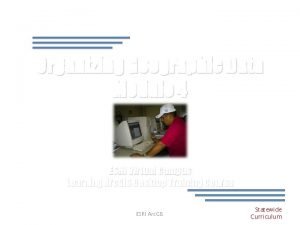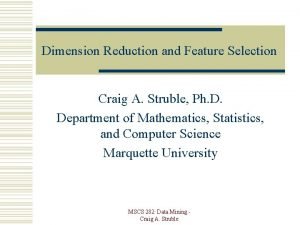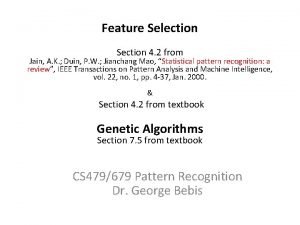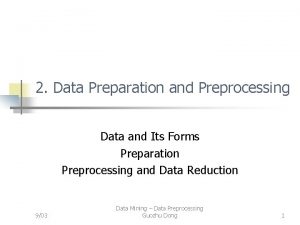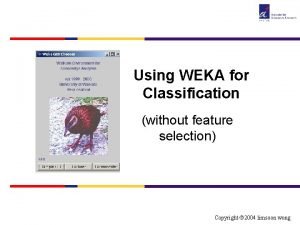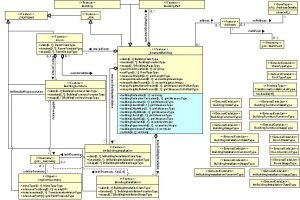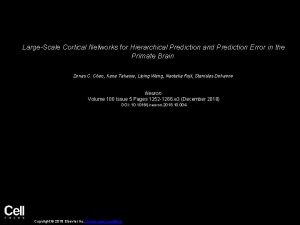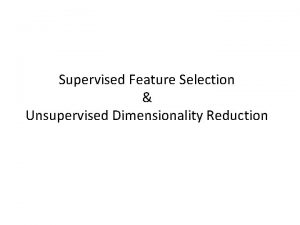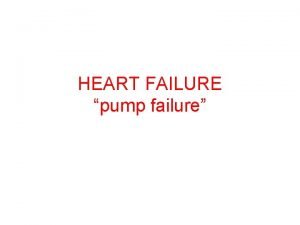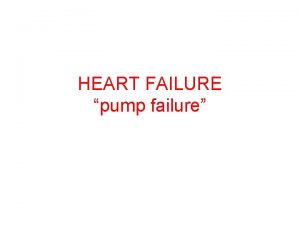General Feature Selection for Failure Prediction in Largescale



















- Slides: 19

General Feature Selection for Failure Prediction in Large-scale SSD Deployment Fan Xu 1, Shujie Han 2, Patrick P. C. Lee 2, Yi Liu 1, Cheng He 1, and Jiongzhou Liu 1 1 Alibaba 2 The Group Chinese University of Hong Kong 1

Motivation Ø Solid-state drive (SSD) failures are prevalent in production Ø Machine learning techniques complement traditional redundancy protection schemes • Self-Monitoring Analysis and Reporting Technology (SMART) logs Ø Feature selection for general SSD failure prediction • One feature selection approach may be inapplicable for all drive models • Various feature selection approaches may select different sets of features • Considering SSD characteristics, how to select features? 2

Our Contribution Ø Measurement study on nearly 500 K SSDs at Alibaba • Feature importance characterization Ø WEFR, general feature selection for SSD failure prediction • An automated and robust manner • Update features with wear-out degree Ø Evaluation on nearly 500 K SSDs at Alibaba • Improve F 0. 5 -score by 10% (4 -6%) compared to no feature selection (existing approaches) with comparable runtime performance Ø Release our dataset for public use 3

Data Collection Ø Collect nearly 500 K SSDs of 6 drive models from 3 vendors over two-year span (Jan. 2018 - Dec. 2019) at Alibaba Ø Data types: SMART logs and trouble tickets 4

Background Ø SSD Failure prediction • • Offline classification problem View raw and normalized values of each SMART attribute as two features Input variables: a vector of features Output variable: drive status (0 means healthy and 1 means failed) Ø Feature selection approaches • Pearson correlation, Spearman correlation, J-index, Random forest (RF), and XGBoost 5

Feature Importance Characterization Ø Feature importance for SSD failure prediction • Feature importance: effectiveness of features for predicting SSD failures • Feature importance scores for all features using Random forest • Different correlations between features and SSD failures • Trivial features as noises may decrease the prediction accuracy 6

Feature Importance Characterization Ø Feature importance using different selection approaches • Rankings of top five important features vary across feature selection approaches • Which feature selection approach is more effective? • How many important features should we select? 7

Feature Importance Characterization Ø Feature importance with different wear-out degrees • Use normalized value of media wear-out indicator (MWI_N) • Measure survival rate on each value in the range of MWI_N • Survival rate changes with MWI_N for MA 1, MA 2, MC 1, and MC 2 • SSD characteristics may change with the wear-out degree Fig. 1: Relationships between the survival rate and MWI_N. Green points are change points detected using the Bayesian change point detection. We omit MB 1 and MB 2 here due to a small range of MWI_N. 8

Feature Importance Characterization Ø Feature importance with different wear-out degrees • Divide SSDs into two groups by the threshold of MWI_N • Top five important features vary across different groups of MWI_N • Need to update features when predicting SSD failures with MWI_N 9

WEFR Ø Wear-out-updating Ensemble Feature Ranking • General feature selection for SSD failure prediction Ø Challenges and key techniques • Robust feature selection • Combine different feature selection approaches • Automated feature selection • Determine the number of selected features automatically • Updating feature selection • Select features with different values of MWI_N • Update the selected features over time 10

WEFR Ø Workflow • Input: all features of SMART attributes from the same drive model • Robust feature selection • Perform preliminary feature selection • Filter out the outlier feature selection approach by checking similarities of rankings • Automated feature selection • Automatically determine the feature count • Updating feature selection • Detect change points for survival rate • Update selected features with wear-out degree • Output: selected features 11

WEFR Ø Robust feature selection • Perform preliminary feature selection approaches • Examine the similarity between rankings of preliminary feature selection • Filter out the outlier feature selection approach Ø Automated feature selection • Measure feature effectiveness and determine feature count automatically Ø Updating feature selection • Detect change points of survival rate and divide SSDs into different groups of MWI_N • Update features for each group of MWI_N periodically 12

Evaluation Ø Methodology • The first 21, 22, and 23 months as training phases for the 22 th, 23 th, and 24 th month as testing phases • Set ratio of training period length to validation period length as 8: 2 • Use Random Forest as prediction model Ø Metrics • Precision, recall, F 0. 5 -score • F 0. 5 -score is to weigh precision twice as important as recall, so as to reduce the cost of replacing a healthy SSD 13

Evaluation Ø Effectiveness of robust feature selection • Overall, WEFR improves F 0. 5 -score by 10% compared to no feature selection • WEFR generally improves F 0. 5 -score by 4 -6% compared to the state-ofthe-art feature selection approaches 14

Evaluation Ø Effectiveness of automated feature selection • F 0. 5 -score of WEFR is always higher than or equal to the highest F 0. 5 score when fixing the percentage of selected features 15

Evaluation Ø Effectiveness of updating feature selection • WEFR improves precision and F 0. 5 -score with updating selected features for MA 1, MA 2, MC 1, and MC 2 compared to no updating feature selection 16

Evaluation Ø Runtime of state-of-the-art feature selection and WEFR • Average runtime with MC 1 over 20 rounds • Spearman correlation is the slowest one among state-of-the-art approaches • WEFR executes state-of-the-art approaches in parallel, so its runtime is comparable with those approaches 17

Conclusion Ø WEFR, general feature selection to select features from SMART attributes • Robust feature selection • Determine feature count automatically • Update features with wear-out degree Ø Evaluation on nearly 500 K SSDs • WEFR generally improves the prediction accuracy across six drive models Ø Dataset: • https: //github. com/alibaba-edu/dcbrain/tree/master/ssd_smart_logs 18

Thank You! Q&A 19
 Non conducted pac ecg
Non conducted pac ecg Failure to capture vs failure to sense
Failure to capture vs failure to sense Ductile failure example
Ductile failure example Feature dataset vs feature class
Feature dataset vs feature class Isolated feature combined feature effects
Isolated feature combined feature effects Information gain feature selection
Information gain feature selection Information gain feature selection
Information gain feature selection Sequential feature selection
Sequential feature selection Data preparation and preprocessing
Data preparation and preprocessing Weka feature selection
Weka feature selection Balancing selection vs stabilizing selection
Balancing selection vs stabilizing selection Artificial selection vs natural selection
Artificial selection vs natural selection K selection r selection
K selection r selection Natural selection vs artificial selection
Natural selection vs artificial selection Artificial selection vs natural selection
Artificial selection vs natural selection Example of sexual selection
Example of sexual selection K selection r selection
K selection r selection Natural selection vs artificial selection
Natural selection vs artificial selection Two way selection and multiway selection
Two way selection and multiway selection Multiway selection in c
Multiway selection in c



